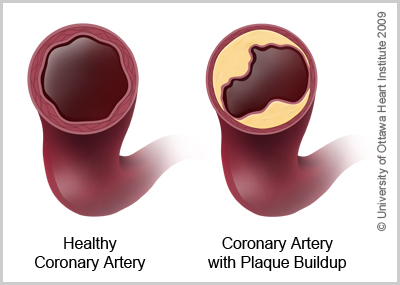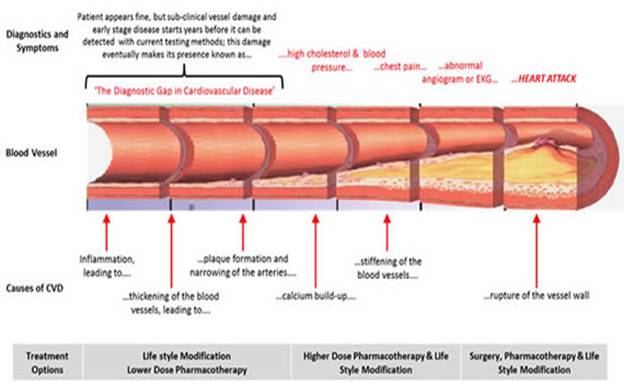Causes of Cardiovascular Disease
A combination of genetic and lifestyle factors causes cardiovascular disease. Certain genetic attributes play a large part in our risk for cardiovascular disease and a series of lifestyle factors known as health behaviors and health factors.
Cardiovascular health involves modifiable health behaviors (mental health, weight management, not smoking, physical activity, and healthy eating) and health factors (cholesterol, blood pressure, and blood sugar).
WHAT IS CARDIOVASCULAR DISEASE?
 Heart disease, also known as Cardiovascular Disease (CVD), is a general term for a variety of conditions that affect the heart and blood vessels. It is a chronic disease that can lead to heart attack and even death. Heart disease is the second leading cause of death in Canada1 and the first worldwide.
Heart disease, also known as Cardiovascular Disease (CVD), is a general term for a variety of conditions that affect the heart and blood vessels. It is a chronic disease that can lead to heart attack and even death. Heart disease is the second leading cause of death in Canada1 and the first worldwide.
The most common form of heart disease is Coronary Artery Disease, which results from atherosclerosis, also referred to as the hardening (and narrowing) of the arteries. Coronary artery disease is the result of a combination of genetic and lifestyle factors. These are called risk factors.
Although the exact process that causes atherosclerosis isn’t known, over time, unhealthy behaviours lead to damage within the lining of the artery walls, encouraging plaque buildup. Plaque is made of several substances, including cholesterol. This buildup is what causes the arteries to narrow, leading to atherosclerosis, and it can start at an early age.
Atherosclerosis can cause a narrowing in the arteries (see diagrams) throughout the cardiovascular system, which can slow or block blood flow. Poor blood flow to the brain can result in stroke. Chronically poor blood flow to the arms or legs is called Peripheral Artery Disease (PAD). Coronary artery disease inhibits blood flow to the heart and can cause Angina or a heart attack.

It’s important to identify cardiovascular disease as early as possible to prevent and reduce further damage. Also critical is understanding how risk factors affect the development of CVD in the first place:
- Risk factors for cardiovascular disease are present as early as age 20.
- Reducing risk factors before the first heart attack or stroke can prevent or postpone 33% of all deaths.2
- Reducing risk factors for heart disease also reduces the risk of death from other chronic diseases.2
- Women and men share most risk factors, but the significance of these risk factors is different:3
- Smoking is particularly harmful in young women.
- High blood pressure, diabetes, and high cholesterol have a greater impact on women than they do on men and are more likely to cause complications.
- Stress, depression, and anxiety put more women at risk than men.
Visit the Canadian Women’s Heart Health Centre for more information on women’s heart health.
PREVALENCE OF CARDIOVASCULAR DISEASE
Cardiovascular disease (CVD) has a large impact on the health of Canadians. Approximately 2.6 million Canadians over the age of 20 live with diagnosed heart disease and it remains the second leading cause of death in Canada.4
A large percentage of the population is at risk of developing CVD or experiencing a second heart attack, stroke, or other CVD-related crisis. Without an eye toward prevention, the aging process and rise in diabetes and obesity will likely increase CVD rates.5
- Nine in 10 Canadians older than age 20 have at least one risk factor for CVD.4
- 2.6 million Canadians live with diagnosed heart disease.4
- Every five minutes in Canada, one person dies from heart conditions, stroke or vascular cognitive impairments.5
COST OF CARDIOVASCULAR DISEASE
Even though, in Canada, cardiovascular disease is second only to cancer in the lives it takes, most people aren’t aware of the threat. CVD places a high financial burden on society and has a significant impact on quality of life. It is the costliest chronic disease the Canadian health care system faces, as the following points illustrate:
- Cardiovascular disease contributes as much as $21.2 billion to healthcare costs each year.5
- In 2016, CVD was responsible for the largest number of hospitalizations in Ontario and the highest number of new cases of chronic disease.6
- In Ontario, the estimated total economic burden for risk factors of heart disease is $7 billion for smoking, $4.5 billion for alcohol consumption, $2.6 billion for physical inactivity, and $5.6 billion for poor nutrition choices.6
IMPORTANCE OF CARDIOVASCULAR DISEASE PREVENTION
According to the World Health Organization, between 2015 and 2050, the proportion of the world's population over 60 years will nearly double from 12% to 22%. The resulting burden on the healthcare system could be overwhelming.7
As you age, your risk for CVD increases. This is a result of physiological changes and uncontrolled risk factors — particularly diabetes and obesity. Although the risk for CVD begins in the second decade of life and the disease is not restricted to older people, the aging process has a clear impact on cardiovascular health.
Added to the expected worldwide health burden of our aging population is the prevalence of obesity and physical inactivity among children, which seems likely to mean an even greater future uptick in cardiovascular disease and shorter life expectancies. If current projections are correct, today’s children may live two to five fewer years than their parents. However, it’s believed that the CVD risk factors associated with this particularly sedentary generation could be reversed with healthy lifestyle habits starting early in adulthood.5
We know a lot about the risks for CVD and how to manage the disease. Still, many of us continue to make unhealthy lifestyle choices.
Early diagnosis and treatment of the modifiable risk factors can significantly reduce the chances you’ll experience a first heart attack, stroke, or other CVD crisis.
The risky lifestyle choices Canadians are making can be seen in these statistics:
- Roughly 49.2% of the Canadian population fails to get the recommended amount of physical activity.9
- In 2017, only 28.6% of Canadians 12 and over reported they had fruits and vegetables more than five times per day.10
- Over 5 million Canadian adults have obesity which increases their risk for diabetes, high cholesterol, and high pressure.11
- Approximately 2.3 million Canadians over the age of 12 have been diagnosed with diabetes.12
- The number of Canadians with high blood pressure is on the rise for those over the age of 35 amounting to 78.6%. 13
- 14.8% of the Canadian population is made up of daily smokers. Smoking increases the risk for high blood pressure and narrowing of the arteries.14
Up to 80% of CVD could be avoided if more people, including healthcare providers, took seriously the very real dangers of heart disease. Even those who know the risks or are living with the disease have difficulty acknowledging that CVD poses any real threat to health. This indicates the gap between an individual’s perceived and actual risk.
Cardiovascular disease is often seen as merely an incident, rather than a chronic problem, particularly in the case of heart attack or stroke. The treatment of these acute episodes is viewed as a cure. Patient education is key to changing this view and to the adoption of heart-healthy lifestyles that will decrease lifetime risk.
With a continuous effort put into education and awareness, there can only be improvement in the perceptions, understanding, care, and outcomes related to cardiovascular disease.
References
- Statistics Canada (2022, January 24). Leading cause of death, total population, by age group. https://www150.statcan.gc.ca/t1/tbl1/en/tv.action?pid=1310039401
- Kottke, T. E., Faith, D. A., Jordan, C. O., Pronk, N. P., Thomas, R. J., & Capewell, S. (2009). The comparative effectiveness of heart disease prevention and treatment strategies. American journal of preventive medicine, 36(1), 82–88. https://doi.org/10.1016/j.amepre.2008.09.010
- Maas, A. H., & Appelman, Y. E. (2010). Gender differences in coronary heart disease. Netherlands heart journal: monthly journal of the Netherlands Society of Cardiology and the Netherlands Heart Foundation, 18(12), 598–602. https://doi.org/10.1007/s12471-010-0841-y
- Public Health Agency of Canada: Canadian Chronic Disease Surveillance System (2022, July 28). Heart disease in Canada. https://www.canada.ca/en/public-health/services/publications/diseases-conditions/heart-disease-canada.html
- Heart and Stroke Foundation of Canada (2019). Dis(connected): How unseen links are putting us at risk. 2019 Report on Heart, Stroke and Vascular Cognitive Impairment. https://www.heartandstroke.ca/-/media/pdf-files/canada/2019-report/heartandstrokereport2019.ashx
- Cancer Care Ontario and Public Health Ontario. (2019, July 19) The burden of chronic disease in Ontario. Key estimates to support efforts in prevention. https://www.ccohealth.ca/sites/CCOHealth/files/assets/BurdenCDHighlights.pdf
- World Health Organization (2022, October 1). Ageing and health. https://www.who.int/news-room/fact-sheets/detail/ageing-and-health
- Park, J. H., Moon, J. H., Kim, H. J., Kong, M. H., & Oh, Y. H. (2020). Sedentary Lifestyle: Overview of Updated Evidence of Potential Health Risks. Korean journal of family medicine, 41(6), 365–373. https://doi.org/10.4082/kjfm.20.0165
- Statistics Canada (2021, September 1). Canadian health measures survey: Activity monitor data. 2018-2019. https://www150.statcan.gc.ca/n1/daily-quotidien/210901/dq210901c-eng.htm
- Statistics Canada (2019, April 30). Health fact sheets: Fruit and vegetable consumption, 2017. https://www150.statcan.gc.ca/n1/pub/82-625-x/2019001/article/00004-eng.htm
- Obesity Canada (n.d.) Obesity in Canada. https://obesitycanada.ca/obesity-in-canada/
- Statistics Canada (2018, November 18). Health fact sheets: Diabetes, 2017. https://www150.statcan.gc.ca/n1/pub/82-625-x/2018001/article/54982-eng.htm
- Statistics Canada (2022, January 24). High blood pressure, by age group. https://www150.statcan.gc.ca/t1/tbl1/en/tv.action?pid=1310009609
- Statistics Canada (2020, October 22). Health fact sheets: Smoking, 2019. https://www150.statcan.gc.ca/n1/pub/82-625-x/2020001/article/00003-eng.htm

